
| Home | Week 1 | Week 2 | Week 3 | Week 4 | Week 5 | Week 6 | |
|---|---|---|---|---|---|---|---|
Teacher's Corner
Week 2 Lesson Plan
Here is a sampling of Maryland State standards met:
CCSS.ELA-Literacy.SL.K.5
Add drawings or other visual displays to descriptions as desired to provide additional detail.
CCSS.ELA-Literacy.SL.K.6
Speak audibly and express thoughts, feelings, and ideas clearly.
Children did both of these when they worked on their bug stories and shared them with the class.
CCSS.Math.Content.K.CC.A.3 Write numbers from 0 to 20. Represent a number of objects with a written numeral 0-20
While the 20 children transition from meeting to other activities they keep track of the amount leaving by writing it on the white board.

Science 1A1f- Suggest things that you could do to find answers to questions raised by observing objects and/or phenomena .
Many of the questions in the children's list included things they had observed such as, "Why do mosquito bite?" and "How do fireflies get their lighting?" When asked where they could find the answers, children said, "Experts, the computer, and books."
Art 31a- Experiment with processes, and techniques and identify ways they can be used to express thoughts and feelings
For story time, classic books by Eric Carle were read with particular attention to his art work. Eric Carle wrote many picture books with bugs in them. Special Eric Carle tissue paper was available at the art table and several children tried their hand at creating art in the style of Eric Carle.

Week 2


To get a better idea of what the children knew about bugs and to spark interest with a writing prompt, campers were asked to write a "bug" story. They were told it could be fiction or nonfiction. Most children dictated their stories and a teacher wrote their words. Two children were able to use inventive spelling and write all of the words for themselves. Everyone illustrated their stories and finally they were shared with the class and put on display. The boy on the rights story says, "This is a caterpillar. It is staying in it's cocoon for fifty years." Another story went, "I found a Japanese Beetle in my net. I want to keep him for my pet." One girl wrote, "Once upon a time, there was a lady bug. It was raining and she hid in the dirt. Then the rain stopped and the sun came out. The lady bug came out and and went East."

To give focus to the study a list of questions was generated from the students. This is by no means a complete or final list. Questions will be added as they come up.
This list helps invest the children in the research and gives the teachers an idea of the direction of the study. For instance, there are questions about specific bugs that the teachers could look for books or video clips on. There are several questions on how and why bugs move which can be explored too.
The field trip for this week was to the UMD's Entomology Department's bug collection. Ahead of time, the word entomologist was introduced. Grace Anderson, a graduate student in the department, laid out many cases of bugs for the children to peruse. The children were amazed that all of the bugs were dead. One girl commented, "It's not very nice to kill bees."  Ms. Anderson assured the children that this was a way to study the insects and get a better look and she added that they also study live insects and showed the children some traps they use to sort through leaf litter and get the bugs to come out. Other comments from the children included, " They have different wings. This one is orange and black and that one is yellow and black. The grasshopper is interesting because it has pink wings. This is the same bug that is in our classroom. They have pokey things coming out of the back." A group thank you note was written on chart paper for Ms. Anderson. Children drew insect pictures around the margin.
Ms. Anderson assured the children that this was a way to study the insects and get a better look and she added that they also study live insects and showed the children some traps they use to sort through leaf litter and get the bugs to come out. Other comments from the children included, " They have different wings. This one is orange and black and that one is yellow and black. The grasshopper is interesting because it has pink wings. This is the same bug that is in our classroom. They have pokey things coming out of the back." A group thank you note was written on chart paper for Ms. Anderson. Children drew insect pictures around the margin.
Etc. Some children planted seeds to grow plants that butterflies liked. We will see how far they grow by the end of camp. The CYC is fortunate to be surrounded by gardens many with native plants and flowers that attract butterflies and other pollinators.
Small and large meal worms were added to the science area for children to touch and observe. In fact one of the questions came from these observations.
The teachers began reading Charlottes Web by E. B. White to the children as they lay down to rest.